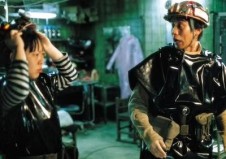Seeing Is Not Believing: Tribulation 99 / Save the Green Planet!

Save the Green Planet!
The UCLA Film & Television Archive and Los Angeles Filmforum present
Science Fiction Against the Margins:
Seeing Is Not Believing: Tribulation 99 / Save the Green Planet!
Friday November 15, 2024, 7:30pm
At the Billy Wilder Theater at the Hammer Museum
More info at: https://cinema.ucla.edu/events/2024/11/15/tribulation-99-save-the-green-planet
Admission is free. No advance reservations. Your seat will be assigned to you when you pick up your ticket at the box office. Seats are assigned on a first come, first served basis. The box office opens one hour before the event.
Special thanks to our community partners: CalArts Office of Alumnx and Family Engagement, Korean Cultural Center of Los Angeles, Los Angeles Filmforum.
Science Fiction Against the Margins showcases filmmakers who occupy the “margins” of mainstream cinema in order to challenge and subvert the science fiction genre. Hollywood’s ubiquitous sci-fi story structure functions within the conventions of action-driven melodrama, resolving social issues in private, emotional and moral terms that reinforce the status quo. This series offers an alternative body of media wherein a speculative mode of thinking outside familiar expectations of narrative resolution opens up representations of race and ethnicity, gender politics and cultural identity. While the focus is on the feature film as a global form of mass entertainment, the series also includes documentaries, shorts, video art and television episodes.
The titles selected reflect a global scope, including films from various regions of the world as well as those by minority and Indigenous cultures. Central to the program is investigating how different independent and international cinemas utilize speculative fiction as a means of exposing inequality — the rationalization of authoritarian rule, capitalist exploitation of racialized labor and environmental imperialism. The series rejects the notion of an underlying “sameness” across cultures and social protests, instead bringing attention to the divergent ways in which social identity, cultural context and material relations are represented by media artists.
Science Fiction Against the Margins reimagines the relationship between science and art by challenging and sometimes finding new inspiration in old cinematic traditions. Works span the history of world cinema, including reflections on colonialism and the moon in Georges Méliès’ A Trip to the Moon (France, 1902), Nuotama Bodomo’s Afronauts (Ghana, 2014) and Yosep Anggi Noen’s The Science of Fictions (Indonesia, 2019). Several films offer speculative visions of societies struggling to overcome dictatorship, whereby the present is explained as either one of collective madness or of a planet under alien invasion, such as Man Facing Southeast (Eliseo Subiela, 1986). In other films, the future presages the total privatization of critical resources supporting human existence, envisioning an endgame brought about by forced labor, political subjugation and environmental collapse, as in Sleep Dealer (Alex Rivera, 2008), Pumzi (Wanuri Kahiu, 2009) and Neptune Frost (Saul Williams, Anisia Uzeyman, 2021). Overall, the series explores an alternative mode of science fiction that raises critical questions rather than offering comforting answers.
—Science Fiction Against the Margins Curatorial Team: Paul Malcolm, Maya Montañez Smukler, Chon Noriega, Nicole Ucedo
Science Fiction Against the Margins is part of this year’s PST ART: Art & Science Collide, presented by Getty. For more information visit pst.art.
https://cinema.ucla.edu/events/2024/science-fiction-against-the-margins


Stranger Baby
Stranger Baby
U.S., 1995, 16mm, b&w, 14 min. Director: Lana Lin.
As part of the production process for Stranger Baby, artist and filmmaker Lana Lin first asked viewers to speculate on its montage of science fiction imagery, documentary footage and home movies, then folded their responses back into the film as a soundtrack of “collaged micro-narratives and interviews that report on the multiple meanings of the term ‘alien.’” The result produces its own haunting, evocative oscillation between alienation and recognition around gender and racial identities.—Paul Malcolm
To Infinity and Beyond
Thailand, 2004, DCP, color, 11 min. Director: Sompot Chidgasornpongse.
Simple in construction and powerful in effect, Sompot Chidgasornpongse’s To Infinity and Beyond consists of two parts. In both we are treated to scenes of a large, festive crowd picnicking in an open field with seemingly everyone who is not singing, playing or eating looking up at the sky. In the first part, intertitles give a brief account of the Cold War space race culminating in the Apollo 11 moon landing. In the second, scrolling text describes life in the village — the farmers, the kids going to school, the changing seasons. Before we know it, we’re caught in a binary between up there and down here and the yearning to explore set against the needs, the wants, the comforts of home.—Paul Malcolm
Fever Dream
U.S., 2021, DCP, color, 11 min. Directors: Suzanne Kite, Devin Ronneberg.
The film version of a multimedia installation created by Indigenous artists Suzanne Kite (Oglala Lakota) and Devin Ronneberg (Kanaka Maoli/Okinawan), Fever Dream flows, as its title implies, like a techno hallucination of video fragments, sound bites and glitches as it plumbs the depths of the “settler psyche.” Carried along in the rhetoric of scientists, crackpots, corporatists and tech bros, the colonialist project, also as the title implies, spreads like a pathology in all directions at once, into the future and the past, outward to the stars and back to ancient lands where Indigenous presence is erased by alien mythologies.—Paul Malcolm

Tribulation 99: Alien Anomalies Under America
Tribulation 99: Alien Anomalies Under America
U.S., 1991, 16mm, b&w, 48 min. Director: Craig Baldwin. With: Sean Kilkoyne.
The propagandist’s art consists of a kernel of truth stirred into a stew of lies. Bay Area found footage maestro Craig Baldwin exposes and critiques the aesthetics of misinformation by messing with the ratios, seasoning heavy helpings of historical facts with a little pure crazy. Drawing on a wealth of fiction and nonfiction images spanning a spectrum from the professionally reputable to the cheapest grindhouse, Tribulation 99 weaves an alternate history of the Cold War and neocolonialism featuring all the usual players — the CIA, United Fruit Company, Howard Hunt, Ronald Reagan, Augusto Pinochet, et al. — working in cahoots with or under the control of a lesser-known villain: refugee space aliens living in Earth’s hollow center. The vast cosmic conspiracy is laid out by a gravelly voiced narrator over a montage moving at a velocity designed to overwhelm reason. Between real and unreal, Baldwin elevates a messianic, apocalyptic through line driving history gratefully toward an ultimate doom.—Paul Malcolm

Save the Green Planet!
Save the Green Planet!
South Korea, 2003, DCP, color, in Korean with English subtitles, 118 min. Director/Screenwriter: Jang Joon-hwan. With: Shin Ha-kyun, Baek Yoon-sik, Hwang Jeong-min.
The first thing Lee (Shin Ha-kyun) tells us in voiceover at the outset of South Korean writer-director Jang Joon-hwan’s darkly comic genre mashup is that he knows he sounds crazy. Of course, it isn’t just his tale of space aliens from Andromeda disguised as South Korean elites bent on destroying Earth that suggests he may not be all right. The hints of childhood trauma and adult tragedy — along with the wall of movies and UFO magazines he keeps in his remote cabin hideout — also suggest Lee is deeply wounded with an equally compensatory imagination. Jang ratchets up the uncertainty only after Lee has kidnapped the president of a major chemical company and begins torturing him to reveal his secret Andromedan plot. As two detectives from Seoul close in, it's unclear if we’re watching a police thriller or a science fiction film (Jang has said he was inspired by Misery) with shocking bits of bloody comedy thrown in for good measure. Deliriously goofy visual and special effects add to the general sense of chaos in a film about the ever-telescoping hierarchy of power that seems to govern, well, everything. In the end, South Korean class politics in which corporate bosses act with impunity while everyone else suffers can’t hold a candle to the games of the elites from beyond the stars.—Paul Malcolm
